![]()
![]()
![]()
Use LEFT and RIGHT arrow keys to navigate between flashcards;
Use UP and DOWN arrow keys to flip the card;
H to show hint;
A reads text to speech;
17 Cards in this Set
- Front
- Back
- 3rd side (hint)
|
AT: Define Anterior Its counter position? |
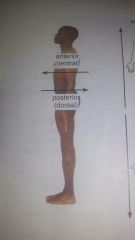
* An anterior body part (in relation to another) is located toeards the front. * posterior |
The trachea is anterior to the esophogus. |
|
|
AT: Define Superrior Its antonym? |
A body part located above another/ toward the head. * inferior: towards the feet |
The face is superior to the neck the neck is inferior to the face |
|
|
AT: Define Medial * its counter term? |
A body part is nearer than another body part to an imaginary midline of the body. * latteral: body prt farther away f4on midline |
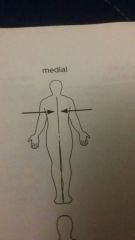
Bridge of the nose is medial to the eyes |
|
|
AT: define proximal * its antagonist? |
Proximal: a body part os closer to the point of attatchment or closer to the trunk * Distal: |
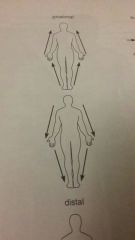
Hand is distal to the elbow |
|
|
AT: define Superficial * its antagonist |
(Exteral):Body prt located near the surface Deep (linternal): body part located away fron the surface |
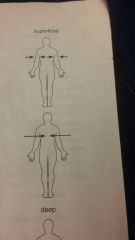
The skin is superficial to the muscles. The intesrines are deep to the spine |
|
|
AT: Define central *It's coubter term? |
Body part is sittuated at the center of the body or an organ * periphial: body pat is sittuated away from the center of bod or an organ |
The periphial nervouse systemn is locatd outside the central nervouse system |
|
|
AT: Define Ipsilateral * its opposirional term? |
Ipsillateral: a body pary is on the same side of the body as another Contralateral: bdy pry is on the opposite side of the body part from the part |
The right hand is ipsilateral to the right foot |
|
|
4 characteristics of anatomical position |
1. Erect 2. Face, toes, and palms foreward 3. Arms at side |
|
|
|
The axial portion of the body includes... |
*head *neck *spinal column *ribs |
4 parts (shrn) |
|
|
The apendicular of the body includes... |
The limbs- * upper * lower |
|
|
|
How is the body obseved when sextioned across a sagital plane? |
The body is divided into right and lefy portions |
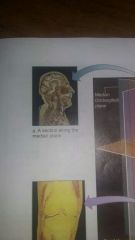
|
|
|
How is the body viwed when cut along a frontal plane? |
One will see the anterior and posterior portions of the body |
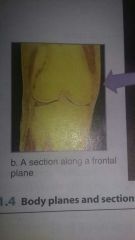
Frontband back |
|
|
BC: the Dorsal cavity os composed of 2 smaller ones: the cranial and vertebral What organs do these cavities carry? |
Cranial cavity: is enclosed by a bony cranial * carries brain Vertebral: enclosed by vertibre * caries the spinal cord |
|
|
|
The meninges is the protective "sheet" lining the dorsal cavity 1.) What are the characteristics the meninges that allows it to protect |
* composed of 3 layers ( closest- furthest)- tightly connected to the brain, mid, tghtly connecyed to the skull In tje attempt to contradict friction. |
|
|
|
What is and What is the importance of the serous membranes |
* they are membranes that line the cavities of the abdominopelvic and thoracic cavity * produces serous fluid that reduce friction when viscera rub |
|
|
|
Syructure of serouse membrane |
Pareiteal serous. Covering body wall Serouse fluid: rduces friction between both Visceral serous. Covering organ |
|
|
|
Homeostasis negative positive |
Sensor - conyril system effector |
|

